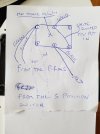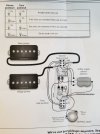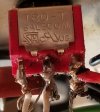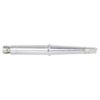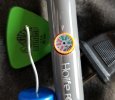So are you splitting to the single or the P90? There are a couple variations on the ON-ON-ON switches. Pretty sure red/green is the single. Glad you got it running.
I'm splitting to the P90, Single, and Both ( what SDuncan calls Humbucker). I should mention I'm assuming that this is what is going on, because it is acting like my previous humbuckers when I attached them to a three position mini toggle. The issue with the other humbuckers was that they weren't specifically designed for this, which I didn't care about, because I still found it worth it for additional different tones. For example, I have found that the parallel mode fattens up the high strings and is really nice for solos, but I would also keep in mind, that this might be effective because of the way the digital amps respond. All of the samples I've posted here in this forum were of my former humbucker in parallel mode.
For those reading who don't know what parallel output is, it means that the two coils of your pickup are outputting at the same time, in other words one isn't going through the other and then to the output, which is what series is, and which is the default state of most humbuckers.
I'd really like to properly learn what's going on with the electronics. For example, if you look at my hand drawn diagram you'll see a line going from terminal 3 to terminal 6, that was put in by a guitar tech, what is it's purpose?
I'm still not sure if I have the switching totally correct, because Seymour Duncan states that the P rail can be a P90, a single coil, and then both of them together making up a humbucker, which I am assuming means that the P90 and single coil are running in series. I'm also assuming that when Seymour Duncan says for example the pickup is in P90 mode, the single coil would be completely deactivated, this is an assumption on my part. I bring this up because after finishing the wiring yesterday, before putting the guitar back together, I tapped on the pickups with a screwdriver, and toggle position one I could hear the tops were a bit louder on the P90 but the single coil still made sound, then when the single coil with switched to the middle I could hear Buzz immediately which I knew was single coil mode, the single coil when hit with the screwdriver sounded louder, but there were still some sound coming out of the P90, and of course in the final mini toggle position both pickups made sound when tapped with a screwdriver. I was expecting when the mini toggle was in position one for example, for the P90 to make a sound when I tapped on the screws, and for the single coil to not make a sound at all when I tapped on it. I don't know if this is normal or not.
